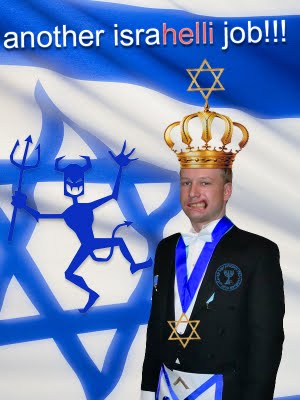An alleged would-be terrorist in Poland, a Swedish serial shooter and an Islamist extremist of Chechen background all have something in common: a connection to American conspiracy culture.
On 20 Nov. 2012, the Polish Internal Security Agency announced that it had arrested a chemistry professor named Brunon Kwiecien at the Agricultural University in Krakow. Kwiecien had allegedly planned to attack the Polish parliament. The authorities seized bomb-making equipment, ammonium nitrate fertilizer and RDX, a high-powered, military-grade explosive. They also seized hundreds of rounds of ammunition, a bulletproof vest and a pistol.
Several international news organizations were quick to point out similarities between Kwiecien’s apparent plot and the attacks carried out by right-wing terrorist Anders Behring Breivik in Norway in July 2011 – that is, an ammonium-nitrate car-bomb explosion at government headquarters in Oslo that killed eight people, followed by a shooting spree at a Labour Party youth camp that killed 69.
According to Polish police and media sources, Kwiecien is indeed a self-proclaimed supporter of the Norwegian terrorist. A source close to the Polish investigation told the Polish news broadcaster TVN 24 that the professor had studied Breivik’s bomb attack and concluded that the Norwegian mass killer had made a number of mistakes.
Breivik and Kwiecien, a comparison
Kwiecien has remained in custody since his arrest on 9 Nov., but the national security agency (known in Poland as the ABW, for Agencja Bezpieczeństwa Wewnętrznego) has not announced the outcome of its investigation. Currently, the Polish chemist is undergoing a court-ordered psychiatric examination. That gives him something else in common with Breivik, who was examined by two separate teams of court-appointed psychiatrists. The first team diagnosed the Norwegian extremist as a paranoid schizophrenic, while the second concluded that he suffers from a narcissistic personality disorder and was not psychotic during the attacks. The court accepted the second finding, effectively ruling Breivik competent under Norwegian law, and sentenced him to at least 21 years’ imprisonment, a sentence that can be prolonged indefinitely.
Mental health issues aside, the Norwegian terrorist was obviously inspired by extreme right-wing ideology, notably by anti-Muslim ideas and conspiracy theories peddled by the so-called counterjihadist blogosphere. Such theories fill much of his 1,518-page “compendium”, a manifesto explaining his extremist ideology, his personal road to terrorism, and his ultranationalist ideals and hopes for the future. Breivik also drew upon other sources, ranging from the Unabomber – he plagiarized lines from the Unabomber Manifesto – to Hindu nationalism.
In the Polish case, early reports indicated that the authorities discovered Kwiecien’s activities while looking into Breivik’s connections in Poland. However, it’s clear that Kwiecien’s open activities on the Internet and his expressions of extremist views even in the offline world prompted the ABW to investigate him and infiltrate a group he had set up. As with Breivik, the chemistry professor’s activities in this virtual sphere give us an opportunity to evaluate his extremist views. What emerges – amongst other things – is a fascination with the theories of a man who is perhaps the leading conspiracy-theory ideologue in the United States.
“Local” or not?
In a comparison between Breivik and Kwiecien, the Polish web newspaper Mowimy Jak points to the Pole’s anti-Semitism and his opposition to Platforma Obywatelska, Poland’s centre-right government party. While anti-Semitism is an important feature of the nationalist right in Poland, Breivik’s anti-Muslim worldview clearly dominates any anti-Semitic ideas he may harbour. He does mention a “Jewish problem” in the United Kingdom, France and the United States, but he also expresses support for Israel and Zionism. Kwiecien’s focus on Europe leads Mowimy Jak to conclude that his ideas are more local in nature than Breivik’s. This conclusion may be somewhat simplistic. While Breivik’s compendium is full of references to the so-called Eurabia theory – that there is a secret plot for a Muslim or Arab takeover of Europe, a plot involving European politicians, academics and journalists – he also has a particular hatred of the Norwegian Labour Party (Arbeiderpartiet). This local focus is evident in his choice of targets, in much of his manifesto and in his courtroom statements. Like Kwiecien, Breivik singled out specific enemies. Kwiecien spoke of a necessary rebellion against the “red bandit” (rudy bandyta) Donald Tusk and – according to the Polish newspaper Gazeta Wyborcza – wanted to kill the well-known journalist Monika Oljenik and the Warsaw mayor Hanna Gronkiewicz-Walts. Breivik fantasized about murdering former Norwegian prime minister Gro Harlem Brundtland and Dagbladet’s left-wing op-ed writer Marte Michelet. For Breivik and Kwiecien alike, local hatreds seem to fit into an international ideology. To the Polish chemist, however, what looms largest is not the threat of Eurabia but another sinister worldwide conspiracy.
In one of his Internet comments, Kwiecien cites the Internet film Wake Up Call, a two-and-a-half-hour self-styled “documentary” made up of clips taken largely from other videos in the same genre – a genre characterized by dramatic music, a creative cut-and-paste methodology and deep conspiracy theories. Amongst the inspiration sources for Wake Up Call is Alex Jones, a leading American conspiracy theorist. Wake Up Call serves as a kind of introduction to a whole spectrum of theories concerning the banking sector, Freemasons, the terrorist attacks of 11 Sept. 2001, etc. Behind it all, it is claimed, is a small clique of elite families with an evil plan to create a totalitarian New World Order.
In another comment, Kwiecien points to another film, Alex Jones’s The Order of Death, in which Jones connects a number of prominent American politicians to an alleged “Satanic Cult” and to a worldwide secret network attempting to create a totalitarian world government. Surprisingly, Kwiecien’s references to Jones have received little attention outside Polish media. While news reports have pointed out the parallels between Kwiecien’s alleged terror plot and the Norwegian attacks of 22 July 2011, the fact that he also drew inspiration from an American conspiracy subculture has gone largely uncovered.
Conspiracy culture and terror
And yet, the Polish chemistry professor would not be the first person seduced towards extremism in this way. Two other examples suggest that generic conspiracy theories, perhaps elevated in stature by the Internet, can inspire very different forms of political extremism.
Between December 2009 and October 2010, a Swede named Peter Mangs carried out a series of shootings in the southern Swedish city of Malmö. The fatal shooting of a 20-year-old woman in October 2009 has also been linked to Mangs. Amongst the victims, she was the only ethnic Swede, but she was in the company of a friend of immigrant origin. In other attacks, Mangs targeted people who had a non-Swedish background, spreading fear in a city with considerable immigrant populations.
What inspired him? A look at his Internet activities reveals several similarities with Kwiecien. According to the Swedish magazine Expo, Mangs wrote a total of 63 user comments on the website Politiskt Inkorrekt (Politically Incorrect), a site with a strongly anti-immigrant profile. Using the nickname UsamaBinLadulås, he promoted anti-Semitic theories, and he recommended the book My Awakening by the internationally prominent anti-Semitic ideologue David Duke. In addition, Mangs was active on vaken.se – an Internet forum that has functioned as somewhat of a hub for Swedish conspiracy-theory believers.
Interestingly, on Mangs’s computer the police also found a list of Jews and others in a supposed secret network, a list drawn up by the Moroccan-Swedish writer and former radio host Ahmed Rami. They also found documents promoting racist ideology. On Twitter, Mangs followed two sites. One of them was Politiskt Inkorrekt. The other was Alex Jones’s Infowars. One might well describe Mangs’s outlook as a “cut-and-paste” ideology compiled from a variety of sources. In a 138-page document produced in prison, Mangs writes about his own intelligence and places himself in the dual role of superhuman and “foot soldier”, fighting against the destruction of the Aryan race.
However, the influence of American conspiracy culture extends well beyond easily classifiable right-wing nationalists. The Associated Press reported that the dead Boston Marathon bombing suspect, Tamerlan Tsarnaev, had shown an interest in Alex Jones’s website Infowars. Salon’s Alex Seitz-Wald described this disclosure as “a bizarre twist befitting a Hollywood conspiracy theory movie”.
Tsarnaev, an ethnic Chechen with U.S. residency, was also interested in anti-Semitic conspiracy theories, including the most notorious of anti-Semitic propaganda works, The Protocols of the Elders of Zion. There is little doubt that extremist Islamist sources, probably including the al-Qaeda-linked Inspire magazine, were the main inspirations for the Boston bombings. But as Seitz-Wald points out, Tsarnaev’s wider interests underscore “how dangerous and seductive conspiracy theories can be”. They also show how relatively “generic” forms of conspiracy theorizing can feed very different forms of political extremism.
Unsurprisingly, Alex Jones alleges not only that the Tsarnaev brothers are scapegoats in a government conspiracy, but that he himself is a victim of conspiracy. “The federal government is trying to connect me to tragedies,” Jones said in one interview, recalling that Richard Andrew Poplawski – a Pittsburgh man who killed three police offers in 2009 – was shown to have visited the Infowars web site on a frequent basis.
“It’s standard for them to talk to people, go through computers, and any time someone’s done something bad, they connect it to us.”


 Print Friendly
Print Friendly







No comments yet.